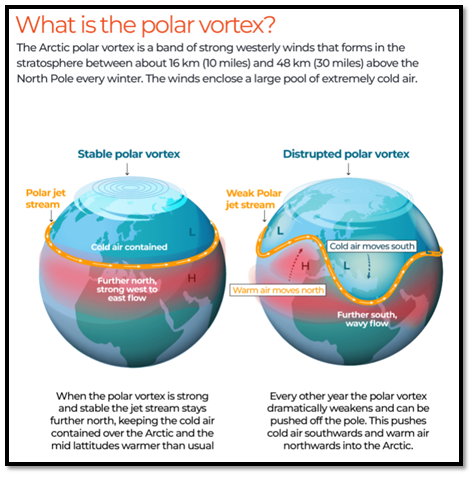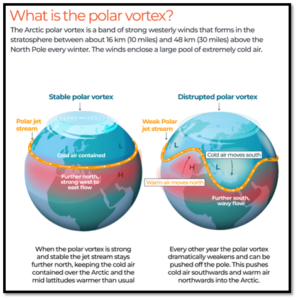
Polar Vortex
Polar Vortex
The article examines the severe winter storm in the US caused by polar vortex disruption, its impacts, and the potential influence of climate change.

Analysis of the news:
Impact of the Winter Storm in the United States
- A severe winter storm has caused widespread disruptions across the United States, leading to the loss of at least five lives, mass school closures, hazardous road conditions, and power outages.
- Approximately 60 million people across 30 states are under weather alerts, with seven states declaring emergencies: Maryland, Virginia, West Virginia, Kansas, Missouri, Kentucky, and Arkansas.
What is the Polar Vortex ?
- The polar vortex is a large, low-pressure system of cold air swirling around the Earth’s polar regions. It exists in two forms:
- Tropospheric Polar Vortex: Found in the lowest layer of the atmosphere (up to 15 km), where most weather phenomena occur.
- Stratospheric Polar Vortex: Located 15–50 km above the surface, strongest in autumn and disappears in summer.
- Extreme cold occurs when the polar vortex weakens, allowing arctic air to travel southward, disrupting weather patterns and leading to cold spells even in regions as far south as Florida.
Role of the Jet Stream in Weather Disruptions
- The jet stream, a strong wind band in the upper atmosphere, typically keeps cold air confined to the poles.
- When the polar vortex weakens, the jet stream becomes wavy and unstable, enabling cold air to spill southward.
- This interaction is a key factor in creating extreme weather conditions during polar vortex disruptions.
Climate Change and the Polar Vortex
- Research is ongoing to determine the exact link between climate change and the polar vortex.
- However, some scientists argue that the accelerated warming of the poles weakens the polar vortex and jet stream, making them more prone to disruptions.
- As global temperatures rise unevenly, the imbalance further destabilizes the system, leading to more frequent and intense cold spells in mid-latitude regions.
ध्रुवीय भंवर
इस लेख में अमेरिका में ध्रुवीय भंवर व्यवधान के कारण आए भीषण शीतकालीन तूफान, उसके प्रभावों और जलवायु परिवर्तन के संभावित प्रभाव की जांच की गई है।
समाचार का विश्लेषण:
- संयुक्त राज्य अमेरिका में शीतकालीन तूफान का प्रभाव
- एक भयंकर शीतकालीन तूफान ने संयुक्त राज्य भर में व्यापक व्यवधान पैदा किया है, जिसके कारण कम से कम पाँच लोगों की जान चली गई, बड़े पैमाने पर स्कूल बंद हो गए, सड़कों की स्थिति ख़तरनाक हो गई और बिजली गुल हो गई।
- 30 राज्यों में लगभग 60 मिलियन लोग मौसम संबंधी अलर्ट के अंतर्गत हैं, जिसमें सात राज्यों ने आपातकाल की घोषणा की है: मैरीलैंड, वर्जीनिया, वेस्ट वर्जीनिया, कंसास, मिसौरी, केंटकी और अर्कांसस।
ध्रुवीय भंवर क्या है?
- ध्रुवीय भंवर पृथ्वी के ध्रुवीय क्षेत्रों के चारों ओर घूमती ठंडी हवा की एक बड़ी, कम दबाव वाली प्रणाली है। यह दो रूपों में मौजूद है:
- क्षोभमंडलीय ध्रुवीय भंवर: वायुमंडल की सबसे निचली परत (15 किमी तक) में पाया जाता है, जहाँ अधिकांश मौसमी घटनाएँ होती हैं।
- समतापमंडलीय ध्रुवीय भंवर: सतह से 15-50 किमी ऊपर स्थित, शरद ऋतु में सबसे मजबूत और गर्मियों में गायब हो जाता है।
- अत्यधिक ठंड तब पड़ती है जब ध्रुवीय भंवर कमजोर हो जाता है, जिससे आर्कटिक हवा दक्षिण की ओर यात्रा करती है, जिससे मौसम का पैटर्न बिगड़ जाता है और फ्लोरिडा जैसे दक्षिण के क्षेत्रों में भी ठंड का दौर शुरू हो जाता है।
मौसम संबंधी व्यवधानों में जेट स्ट्रीम की भूमिका
- जेट स्ट्रीम, ऊपरी वायुमंडल में एक मजबूत हवा का बैंड है, जो आमतौर पर ठंडी हवा को ध्रुवों तक सीमित रखता है।
- जब ध्रुवीय भंवर कमजोर होता है, तो जेट स्ट्रीम लहरदार और अस्थिर हो जाती है, जिससे ठंडी हवा दक्षिण की ओर फैल जाती है।
- यह अंतःक्रिया ध्रुवीय भंवर व्यवधानों के दौरान चरम मौसम की स्थिति बनाने में एक महत्वपूर्ण कारक है।
जलवायु परिवर्तन और ध्रुवीय भंवर
- जलवायु परिवर्तन और ध्रुवीय भंवर के बीच सटीक संबंध निर्धारित करने के लिए अनुसंधान जारी है।
- हालांकि, कुछ वैज्ञानिकों का तर्क है कि ध्रुवों के तेजी से गर्म होने से ध्रुवीय भंवर और जेट स्ट्रीम कमजोर हो जाती है, जिससे वे व्यवधानों के प्रति अधिक संवेदनशील हो जाते हैं।
- जैसे-जैसे वैश्विक तापमान असमान रूप से बढ़ता है, असंतुलन प्रणाली को और अस्थिर करता है, जिससे मध्य-अक्षांश क्षेत्रों में अधिक लगातार और तीव्र ठंड पड़ती है।